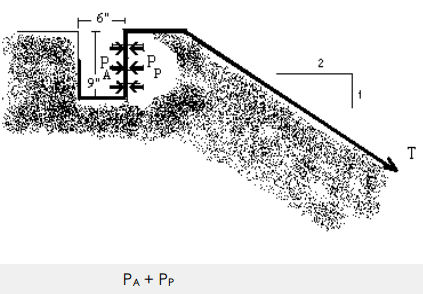Turf Reinforcement Mats
Turf reinforcement mats offer erosion protection and control to hill sides. They help the newly planted vegetation take root in the presence of flowing water. Water exerts extreme force on plants and can thus up-root them in its path.
When it comes to tensile strength, how much is considered enough? The lack of standardized test protocol and lack of standardized specifications for Turf Reinforcement Mats (TRM’s) have led to much confusion in the marketplace. One particular point of confusion lies in the question of how much tensile strength is required of a turf reinforcement mat to provide satisfactory performance?
Channel Linings:
For Channel Linings, there are two widely accepted methodologies that allow the designer to examine the permissible velocity or permissible tractive (shear) force to determine the suitability of a given lining. For slope design, some form of the Universal Soil Loss Equation (USLE) is commonly used. It is important to point out that Tensile Strength is not used in any of these design methods.
A secondary consideration of tensile requirement of TRM’s depends on the severity of the exposure, primarily related to the depth of flow and the topography, as well as on how frequently the TRM is anchored to the ground surface. The most severe case would involve deep flow within a steep channel with infrequent anchoring of the TRM. Conversely, TRM installations exposed only to rainfall impact and sheet runoff on slopes of modest steepness would require minimal tensile strength.
Turf Reinforcement Mats Installation Stresses:
But what about installation stresses? Generally the greatest tensile stresses that TRM’s are exposed to occur during installation. The deployment, edge burial, pinning or stapling, and soil covering (if required) of the TRM may involve pulling on it, walking on it, pounding on it, driving on it, dumping on it, and/or compacting on it. These imposed forces are usually nominal, but they may be important to consider if the installer is inexperienced or careless.
Tension Resulting from Anchorage
The imposed shear will be resisted either by anchorage at points (i.e. pins or staples) or by anchorage in trenches. [The general usage of anchoring devices such as pins or staples is intended as a temporary means of securely fastening the TRM to the soil to ensure intimate contact between the TRM and the soil until vegetation is established. While anchor trenches are permanent and the pins or staples are temporary, it is prudent to assume these devices will contribute some tensile resistance.] These anchorages prevent the TRM from moving with the flow through developing tension in the TRM. The magnitude of the tension can be determined using Equation 1 and multiplying by the contributory area.

Tension Resulting from Anchorage
Calculation of tension resulting from point anchorage. The total required tension to be resisted by each anchorage point can be determined by multiplying the required tension by the contributory area for each anchorage. The contributory area is determined by anchorage spacing. Calculation of tension resulting from trench anchorage. The total required tension to be resisted by an anchor trench can be determined by multiplying the required tension by the contributory area. The contributory area is the unanchored length of TRM below the trench.
For a more in-depth look at this subject, complete with diagrams, please click here.








